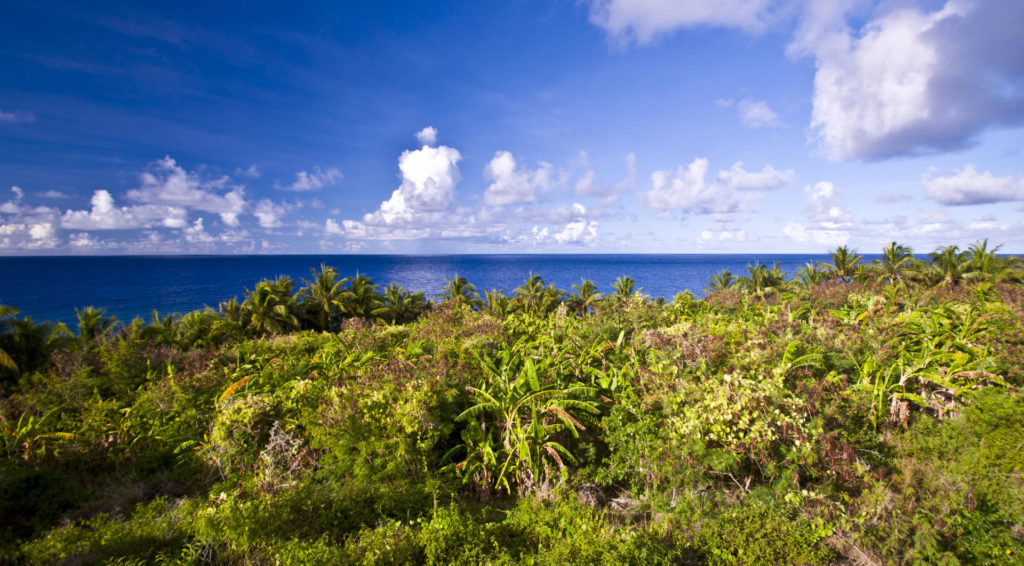Saipan and Rota are more than just quick tropical getaways for travelers from Japan. They are also havens for divers who know they’ll be rewarded time and time again.
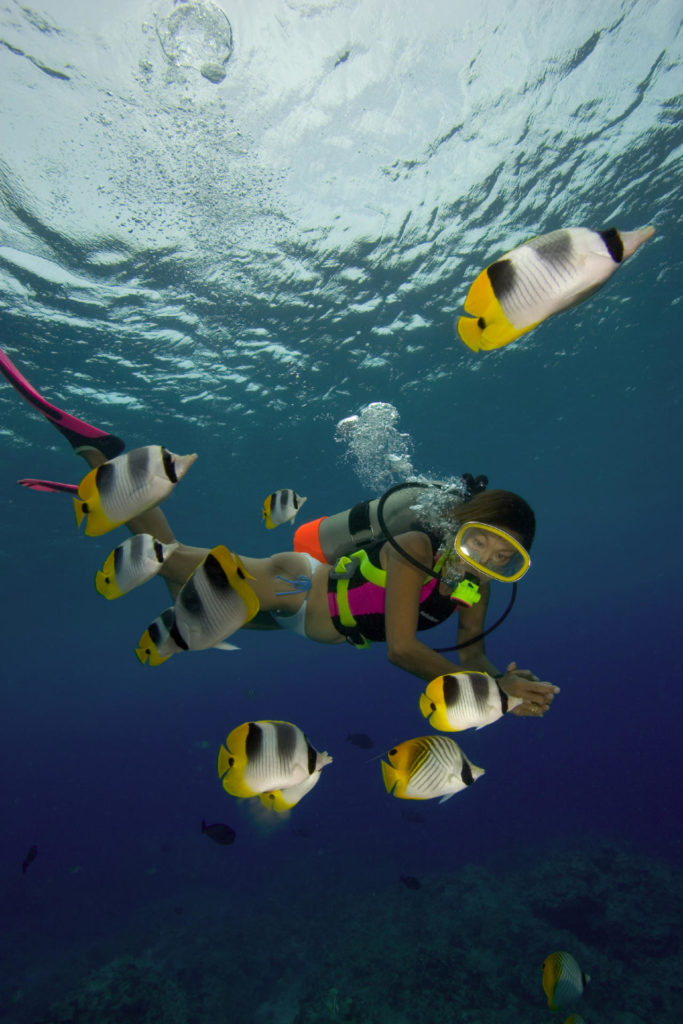
The Commonwealth of the Northern Marianas Islands (CNMI) are “low” coral uplift and volcanic islands with coastlines ranging from rocky cliffs to white and black sand beaches. Some of the islands farther north are still volcanically active. Rota, the southernmost of the CNMI, is a ruggedly beautiful island with a sparse population and some exceptionally clear waters.
It’s just a 20-minute hop from Guam, but it will feel like a new world for the scuba buff. Divers visiting Rota will find the water clarity is astounding. A bad day is 30 meters. The island’s “honeycombed” base extends to the sea, opening up a selection of caves, tunnels and crevices that are fun to explore, full of life and stunning when dived at the right time of day.

Rota is also known as the friendliest island in the Marianas. This may be because of a local greeting custom of waving or nodding when they pass you on the road. There is also Rota’s annual fiesta which takes place in October and features a massive, varied spread of food that is legendary.
Complimenting its generous citizenry is an ample supply of eye-popping scenery, both above and below the sea. Rota is full of rough and tough limestone. Sheer cliffs rise from the sea on the east side, while the west has beaches with badland formations that lead right out to water’s edge.
The island’s charm is not only its people, but also the lack of people. The picturesque villages occupy relatively little space on the island, making it the perfect place to roam. Early morning jaunts may bring a glimpse of a monitor lizard, a shrunken cousin of the feared Komodo dragon. Hiking can be fascinating; one can occasionally find artifacts in caves from World War II or ancient glyphs from the Chamorro people.
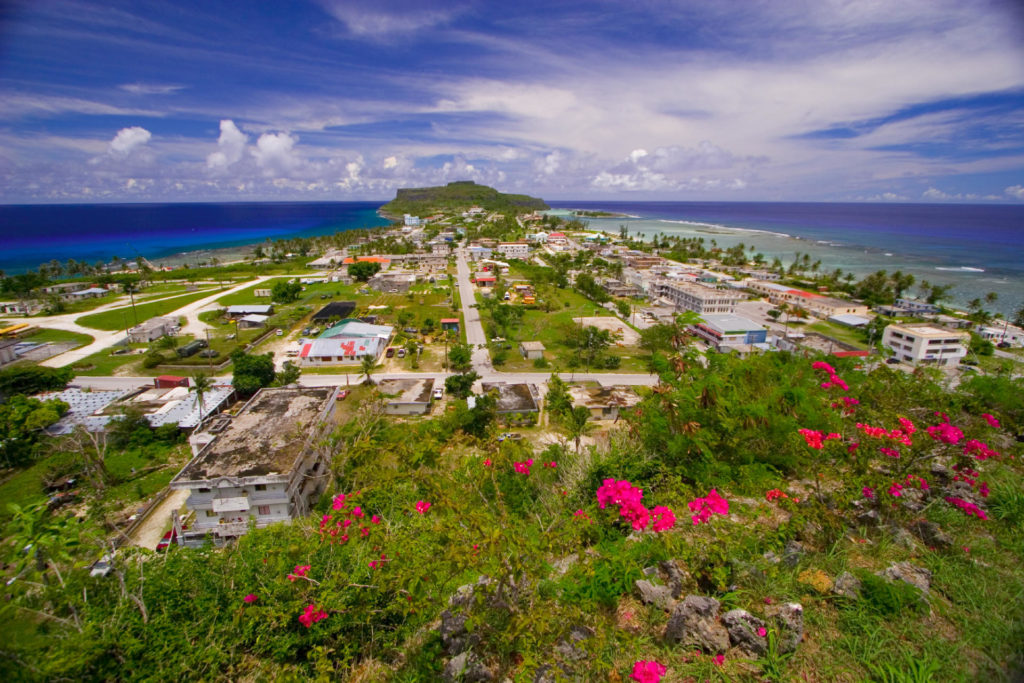
Birds, especially sea birds, are one of the island’s claims to fame. Its bird sanctuary is set in the most scenic of sites. Few places in the Pacific offer the panoramic view of nature you’ll find at the Sagua Ghaga Seabird Sanctuary on the south coast of Rota.
Below Rota’s bird sanctuary, the sea crashes into the cliffs. All along this eastern coastline are natural surprises waiting to be found. It can be rough over here, especially during trade wind season, so much of the underwater world has yet to be explored.
New finds are popping up all the time, and known sites yield new features as more people take time to visit them. Dive Rota owner Mark Michael and divemaster Fumiko Furukawa showed me around the best spots. Pearlman Tunnel is home to a couple of white-tip sharks. The cave has an entrance at about 80 feet and runs up a slope to less than 20 feet where it opens up again.
The silhouette of the sharks swimming nervously back and forth can be seen as the diver enters the cave. Normally not aggressive, the sharks will leave while their home is being explored. However, they usually don’t stray too far, occasionally swimming by on the outer reef to see if it is OK to come back and again rest.
The outer reef is also the home to feeding green sea and hawksbill turtles. They like to eat the algae along the upper reef flat. They have been the subject of recent sea turtle counts to keep better track of the endangered marine reptiles. This site also has a forest of golden gorgonian fans that give off a brilliant hue when the underwater light shines on them. The same with Pona Point, which has an overhang full of golden gorgonians and some nice sea anemones.
One of the more photographed sites on Rota is along the west shoreline at Wedding Cake Point. Puntan Senhanom, literally translated from Chamorro, means “The Water Point.” It is an underwater cavern illuminated by the sun through dual openings.
The dive entails not diving on the sloping reef, but instead dropping down and heading straight for the sheer cliff line. It falls majestically and vertically into the sea. The dark opening of a cave becomes apparent and, at about 40 feet, the cave can be entered.
The cavern itself is huge, and walls are covered in encrusting sponges. The many shelves of this gap tunnel have ledges that sometimes hold sleeping white-tip sharks. The darker reaches of the cave have cowries and other shells. Swim through the chasm to the back, and you can rise to a fresh air opening and see the sky.
Unlike most caves, this one actually gets lighter the deeper you go. The best time to visit here is seasonal, but locals know. This is when the rotating sun streams down through an opening in the cliff and sends shafts of light down through the cave ceiling. It is possible to swim to the light source and rise through it. It is a zen-like experience to watch the light as it dances through the cavern’s waters.
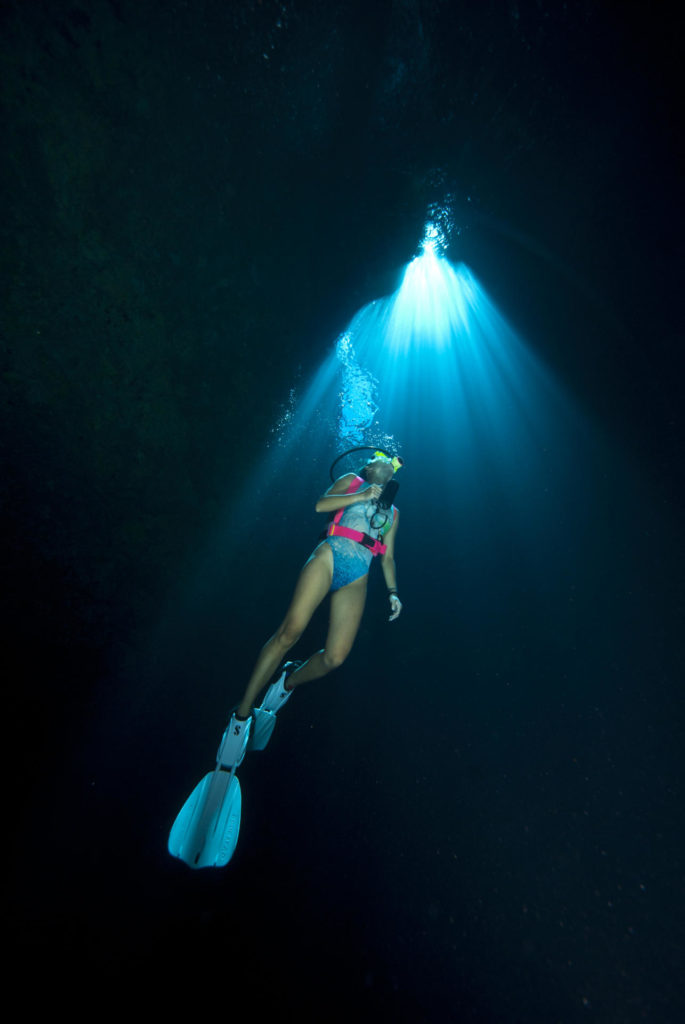
I joined model Elaine Kwok for some great photography at this site. We used the cave’s natural light to try some “underwater ballet” photos in this studio made by nature. It was a new and fun way to enjoy Senhanom.
Rota also has two shipwrecks in the gin-clear Sasanaya Bay. The WW II Japanese freighter Shoun Maru is upright and splayed wide open. The bow still sits high in the water. On most days the diver can see the entire 400-foot long wreck from the surface. Amazing.
There’s also the Seven Screws wreck. This ship plied the rivers of China, but It was confiscated during a smuggling bust and sunk here for sport diving. The seabed around both wrecks is alive with garden eels while white-tip sharks and spadefish like to hover above the Shoun Maru.
Sasanaya Bay was just in the last year declared a marine sanctuary—and with good reason. If you’re lucky, big Pacific bottlenose dolphins will be in the bay and play at the boat’s bow. Even pods of melon-head whales and an occasional humpback visit this amazing bay.
At night, the sky is as clear as the water. There aren’t many lights on Rota, so stargazers are in for a treat. The Southern Cross and Orion punch through the blackness, and the Milky Way is absolutely incredible, flowing across the universe in a shimmering array of creation. Rota can be good for a few days or a week-long getaway adventure. But, for sure, Rota is a natural high.
Eagle Ray City
The island of Saipan is the capital of the Northern Marianas and is a quick three-hour trip from Japan and just a short hop from Guam or Rota. It is a haven for golfers, snorkelers, divers and duty free shoppers. Its western coast has white sand beaches. The interior is full of lush jungle greenery and rugged cliffs. There are some eye-popping botanical gardens here. The island is famous for clear water. Divers are now coming to see a new underwater attraction, schooling eagle rays off Managaha Island.
The Pacfic Islands Club Hotel on the west coast has a large water park, punctuated by a replica of an ancient Manila galleon. It is located right on the hotel grounds and is a tribute to the real Manila galleon trade ship that sunk on the nearby coast. This ship was studied in the 1990s by archeologists and treasure hunters and featured in National Geographic magazine. The “mother load” of the treasure in gold and jewelry is said to still be in the deep offshore waters.
I joined Captain Sam Markos and Saipan dive guru Rick Northen in just 25 feet of water amidst blue seas and bright white sand on the island shore. The eagle ray dive in the harbor, dubbed Eagle Ray City, is an amazing sight. Anywhere from five to 40 rays gather at a couple of current-fed spots in the bay to feed and play in the moving water.
Just sit still and wait, and they may come quite close. The beautiful patterns of the rays and their ballet-like movements are worth holding firm in the currents to snap a few nice shots. This interaction is seasonal, but they are also seen outside the reef at Dimple and Ice Cream dive sites.
Nearby are a couple of WW II airplane wrecks complete with white-tip sharks and resident eels. There are also a couple of wartime shipwrecks in shallow water clouded with schools of goatfish and snappers. On the outer reefs, nice hard corals and fishy spots abound. The Grotto, with its three blue windows to the sea, and laid-back Lau Lau Bay are both worthy spots for a diving visit.
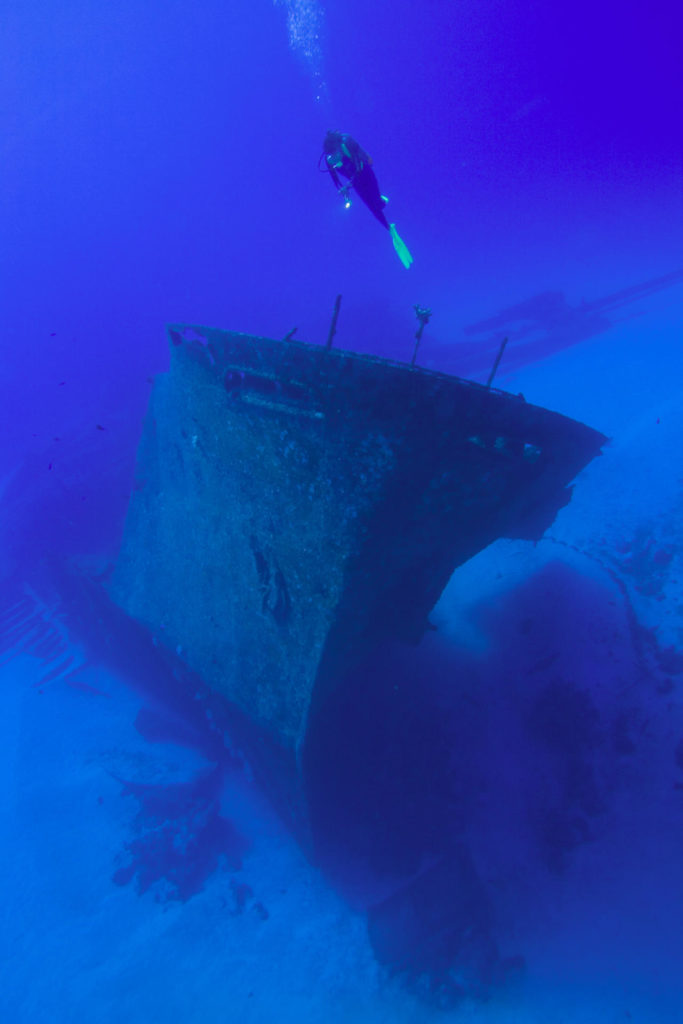
For the visitor wanting to get a good look at Saipan’s famous natural sites, the incredible cliffs and green jungles hold much natural splendor. Take a tour or a drive and see what the island looks like. At Bonsai Cliff, big waves crash against the boulders below, showing the beauty and force of the ocean. Listen as the waves pound in.
Located at “road’s end” along the northern part of the island, Bird Island sits before you like a postcard. This “noddy” and “booby” sanctuary is isolated by a small bay, but easily viewed from a landscaped overlook. At night, Saipan’s legendary sunsets fill the horizon and illuminate WW II tanks that still sit in the western lagoon, giving the visitor time to reflect on the next trip to the CNMI.
General Info: For more information on Rota, Saipan and the Northern Mariana Islands, visit www.visit-marianas.com.
Getting There: Delta Airlines (www.delta.com) has three daily flights from Narita to Saipan and one daily flight from Nagoya to Saipan. Asiana Airlines (www.flyasiana.com) will have one daily flight from Osaka to Saipan starting in Mid-December. Continental Airlines (www.continental.com) has two flights a week from Guam to Rota and three flights a day from Guam to Saipan. Freedom Air (www.freedomairguam.com) has two flights a day from Guam to Rota to Saipan. Be sure to check Web sites for flight schedules as they can change.
Getting Around: The best way to explore the islands is to rent a car. It’s recommended to book before you arrive, or you can arrange through your hotel or lodge.
Immigration, Currency and Electricity: All divers need a valid passport to enter the CNMI. All services on Saipan and Rota, such as currency, post and electricity follow USA standards.
